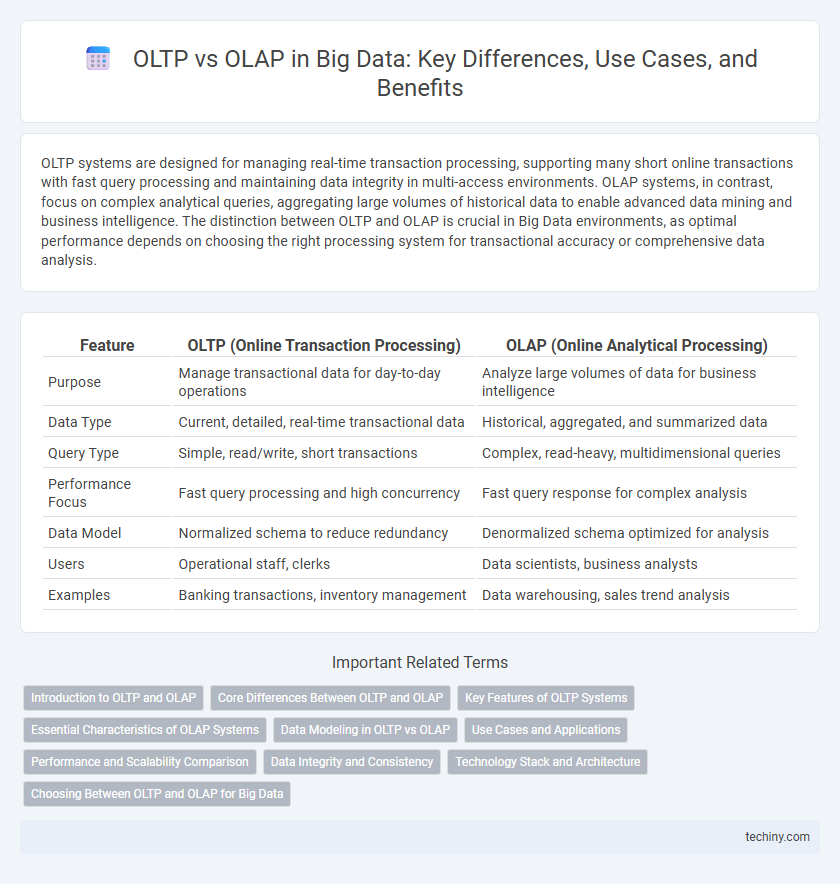OLTP systems are designed for managing real-time transaction processing, supporting many short online transactions with fast query processing and maintaining data integrity in multi-access environments. OLAP systems, in contrast, focus on complex analytical queries, aggregating large volumes of historical data to enable advanced data mining and business intelligence. The distinction between OLTP and OLAP is crucial in Big Data environments, as optimal performance depends on choosing the right processing system for transactional accuracy or comprehensive data analysis.
Table of Comparison
| Feature | OLTP (Online Transaction Processing) | OLAP (Online Analytical Processing) |
|---|---|---|
| Purpose | Manage transactional data for day-to-day operations | Analyze large volumes of data for business intelligence |
| Data Type | Current, detailed, real-time transactional data | Historical, aggregated, and summarized data |
| Query Type | Simple, read/write, short transactions | Complex, read-heavy, multidimensional queries |
| Performance Focus | Fast query processing and high concurrency | Fast query response for complex analysis |
| Data Model | Normalized schema to reduce redundancy | Denormalized schema optimized for analysis |
| Users | Operational staff, clerks | Data scientists, business analysts |
| Examples | Banking transactions, inventory management | Data warehousing, sales trend analysis |
Introduction to OLTP and OLAP
OLTP (Online Transaction Processing) systems handle large volumes of short, transactional queries designed for day-to-day operations and real-time data management. OLAP (Online Analytical Processing) systems focus on complex queries and multidimensional analysis to support business intelligence and decision-making processes. OLTP prioritizes fast query processing and data integrity, while OLAP emphasizes query performance and data aggregation for insights.
Core Differences Between OLTP and OLAP
OLTP systems are optimized for high-volume transaction processing with real-time data entry, focusing on speed and data integrity for daily operations. OLAP systems prioritize complex queries and data analysis, enabling multidimensional insights through aggregated historical data. The core difference lies in OLTP's emphasis on transaction efficiency versus OLAP's focus on analytical processing and decision support.
Key Features of OLTP Systems
OLTP systems are designed for real-time transaction processing, supporting a large number of short online transactions such as insert, update, and delete operations. Key features include high concurrency, rapid query processing, and maintaining data integrity through ACID compliance (Atomicity, Consistency, Isolation, Durability). OLTP databases optimize for operational efficiency, ensuring minimal response time in environments like banking, retail, and reservation systems.
Essential Characteristics of OLAP Systems
OLAP systems are designed for complex queries, enabling multidimensional analysis of large datasets with fast query performance and aggregated data views. They support advanced data modeling techniques such as star and snowflake schemas, providing users with intuitive data navigation and drill-down capabilities. OLAP emphasizes read-intensive workloads, historical data analysis, and seamless integration with BI tools to deliver actionable insights for strategic decision-making.
Data Modeling in OLTP vs OLAP
Data modeling in OLTP systems prioritizes normalization to minimize redundancy and ensure data integrity for transactional operations, typically involving numerous short, atomic transactions. In contrast, OLAP data modeling employs denormalization techniques such as star or snowflake schemas to optimize complex queries and analytical workloads, enabling efficient aggregation and reporting on large volumes of historical data. The distinction in data modeling approaches directly impacts performance, with OLTP models suited for real-time processing and OLAP models designed to facilitate multidimensional analysis and decision support.
Use Cases and Applications
OLTP systems excel in handling high-volume, real-time transaction processing essential for applications like banking, e-commerce, and order management, where data integrity and fast query performance are critical. OLAP systems specialize in complex analytical queries and multidimensional data analysis, supporting use cases such as business intelligence, data mining, and strategic decision-making. Enterprises leverage OLTP for daily operational tasks while relying on OLAP for extracting insights and trends from large historical datasets.
Performance and Scalability Comparison
OLTP systems prioritize high transaction throughput with low latency, ensuring rapid insert, update, and delete operations suitable for real-time applications, while OLAP systems optimize complex query performance over large datasets through read-intensive operations and multidimensional analysis. Scalability in OLTP is often achieved by horizontal partitioning and replication to handle numerous concurrent users, whereas OLAP systems leverage distributed architectures and columnar storage to efficiently process analytical queries across vast data volumes. Performance tuning for OLTP focuses on reducing locking and contention, whereas OLAP emphasizes query optimization and parallel processing to enhance scalability and speed in big data environments.
Data Integrity and Consistency
OLTP systems prioritize real-time transaction processing with strong data integrity and consistency enforced through ACID-compliant mechanisms, ensuring accurate updates in multi-user environments. OLAP systems focus on complex analytical queries over large datasets, often sacrificing some real-time consistency for performance, using eventual consistency models to handle massive volumes of aggregated data. Maintaining data integrity in OLAP requires rigorous ETL processes to cleanse and validate data sourced from OLTP systems.
Technology Stack and Architecture
OLTP systems use a technology stack optimized for high-speed transaction processing, including relational databases like MySQL and PostgreSQL, with architectures supporting ACID compliance and real-time data integrity. OLAP technology stacks emphasize data warehousing solutions such as Amazon Redshift, Google BigQuery, and Apache Hive, built on distributed architectures designed for complex, large-scale analytical queries and multidimensional data modeling. The architectural difference lies in OLTP's normalized schema for efficient inserts and updates, whereas OLAP employs denormalized schemas like star or snowflake for rapid query performance and data summarization.
Choosing Between OLTP and OLAP for Big Data
Choosing between OLTP and OLAP for Big Data depends on the nature of data processing required: OLTP systems excel in handling high-volume transaction processing with real-time data accuracy, while OLAP systems focus on complex analytical queries and multidimensional data analysis for business intelligence. Big Data environments often integrate OLTP for operational data capture and OLAP for deep insights, leveraging distributed architectures like Hadoop or Spark to optimize performance and scalability. Effective selection requires assessing workload patterns, query complexity, latency tolerance, and data integration needs to align with organizational goals and infrastructure capabilities.
OLTP vs OLAP Infographic

 techiny.com
techiny.com